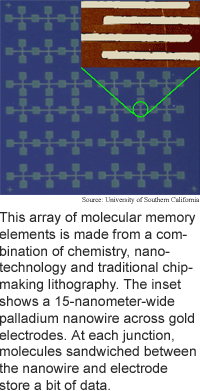
Prefab key to molecular memory
By
Kimberly Patch,
Technology Research NewsIt is one thing to put together a device that works. It is another matter entirely to reliably manufacture thousands of them.
This is one of the challenges facing researchers working on nanodevices -- electrical and mechanical components whose sizes range down to the atomic scale. Such devices promise to use molecules as super-fast computer circuits, store fantastic amounts of information in a minuscule area and sense minute amounts of chemicals and biological materials.
Researchers from the University of Southern California, NASA Ames Research Center and Rice University have brought these possibilities a step closer with a way to gently add electrical contacts to a sheet of molecules to produce molecular memory.
The method increases the yield of viable memory by 30-fold, up from only 1 or 2 percent, said James Tour, a professor of chemistry, computer science, mechanical engineering and materials science at Rice University.
The method is "a solution to the long-standing electric contact issue in making molecular devices," said his colleague Chongwu Zhou, an assistant professor of electrical engineering at the University of Southern California.
Molecular memory devices consist of a layer of molecules sandwiched between metal electrodes. Electric current flows from one electrode to the other through the molecule-thick layer. A high voltage jolt flips the resistance of the molecules, making it easier or more difficult for the current to pass through. A low voltage can measure the resistance of the molecules, and the two resistance levels can represent the 1s and 0s of computer information.
The devices have the potential to store binary information in small numbers of molecules. In addition, smaller electronics would be faster, simply because the currents of electrons that carry signals don't have as far to travel. "Molecular electronics in general has potential to produce ultra-dense and high-performance integrated electronic systems," said Zhou.
To make the molecular memory, the researchers used beams of electrons to form four parallel gold electrodes 150 nanometers wide and spaced 200 nanometers apart. A row while 1,500 hydrogen atoms spans 150 nanometers, which is about one seventh the diameter of an E. coli bacterium.
The researchers chemically coaxed a single layer of molecules to assemble on top of the electrodes, and scratched the molecules off one electrode using an atomic force microscope. They then put pre-made palladium nanowires across the electrodes.
The researchers formed the 10- to 15-nanometer wide nanowires ahead of time by coating carbon nanotubes with palladium. Nanotubes are rolled-up sheets of carbon atoms, and can be smaller than a single nanometer, or the span of 10 hydrogen atoms.
The nanowires formed a direct contact with the electrode where the monolayer was scratched off, and formed junctions with the molecules at the intersections of the other three electrodes.
Forming the top contacts ahead of time makes it possible to gently apply top electrical contacts to a small assembly of molecule-coated electrodes, said Zhou. The method "eliminates long-standing problems like thermal damage and poor yield related to defects in the monolayer," he said. Top contacts are usually added using metal evaporation techniques that subject the device to high temperatures.
The researchers used the method to test several types of molecules and show that they can be used to store information.
They are still working out how the molecules actually switch resistance states. "There are two possibilities," said Zhou. Either a physical twist of the molecules, termed conformation transition, or a chemical change -- a reduction oxidation, or redox reaction. "Our work shed some light on this [but] it is still an open issue," he said. "My best guess is that the memory effects are caused by an interplay of redox and conformation transition," he said.
The researchers are working on constructing prototype molecular memory chips that will hold one kilobit, or 1,000 bits, said Zhou. Today's state-of-the-art computer memory chips hold a gigabit, or one billion bits of information.
In the near-term the higher yield method should allow researchers to make prototype devices more easily. "This can inspire more work toward molecular memory chips... though substantial challenge remains ahead," said Zhou.
It will be more than five years and maybe more than 10 before the method can be used to build practical molecular memory chips and circuits, said Zhou.
Tour and Zhou's research colleagues were Chao Li, Daihua Zhang, Xiaolei Liu, Song Han and Tao Tang at the University of Southern California; Wendy Fan, Jessica Koehne, Jie Han and Meyya Meyyappan from NASA Ames Research Center; and Adam M. Rawlett and David W. Price from Rice University. The work appeared in the January 27, 2003 issue of Applied Physics Letters. The research was funded by the National Science Foundation (NSF).
Timeline: > five years
Funding: Government
TRN Categories: Data Storage Technology; Nanotechnology
Story Type: News
Related Elements: Technical paper, "Fabrication Approach for Molecular Memory Arrays," Applied Physics Letters, January 27, 2003
Advertisements:
June 18/25, 2003
Page One
Chip sorts colors
Software referees group calls
Prefab key to molecular memory
Wires make wireless strain gauge
News briefs:
See-through circuits closer
Protein traps nanoparticles
Nods drive audio interface
Nano rapid prototyping advances
Practical nanotube fiber near
Nanotube transistors make memory

News:
Research News Roundup
Research Watch blog
Features:
View from the High Ground Q&A
How It Works
RSS Feeds:
News
Ad links:
Buy an ad link
| Advertisements:
|
 |
Ad links: Clear History
Buy an ad link
|
TRN
Newswire and Headline Feeds for Web sites
|
© Copyright Technology Research News, LLC 2000-2006. All rights reserved.